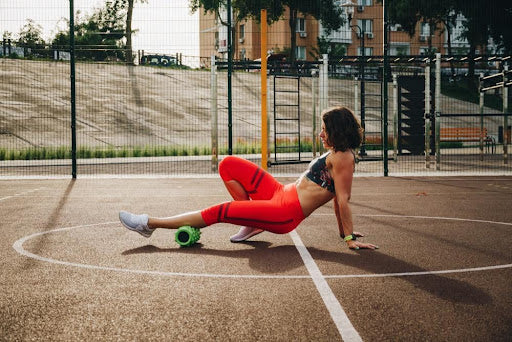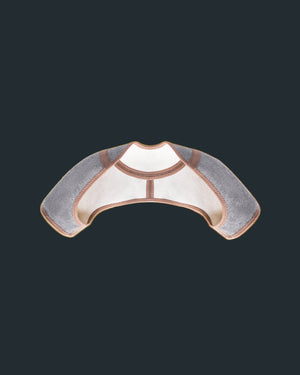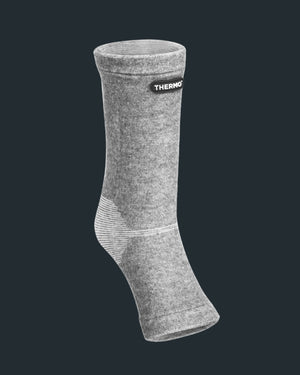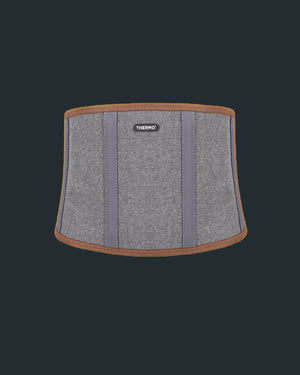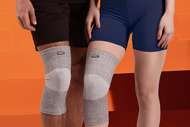Medically reviewed by [Alex Stone, PT, DPT, Certified Strength and Conditioning Specialist] on 2/23/2024
Medically reviewed by [Alex Stone, PT, DPT, Certified Strength and Conditioning Specialist] on 2/23/2024
Are you giving your all during workouts but feeling like you're not seeing the results you want? Your post-workout recovery routine might be the missing piece.
In this article, we’ll break down the eight best post-workout recovery tips for 2024. These simple yet effective strategies will help you bounce back faster, reduce muscle soreness, and get the most out of your training.
So, whether you're an experienced athlete or a fitness newbie, read on to explore how you can supercharge your recovery and take your fitness to the next level.
Let’s get started!
8 Best Post-Workout Recovery Tips
Without further adieu, here are the best post-workout recovery tips that you need to maximize your gains:
1. Keep Your Thermo Recovery Wear on
One of the best ways to recover after a workout involves using recovery wear designed to relieve joint pain. Specifically, Thermo Recovery Wear is one of the best options available today.
What Is Thermo Recovery Wear?
Thermo Recovery Wear is recovery wear designed to alleviate chronic muscle and joint pain by more than 62%. It's comfortable enough to wear 24/7, providing safe, quick, and effective pain relief.
On top of being effective and easy to use, Thermo Recovery Wear comes in different materials and sizes to fit every lifestyle.
Thermo Recovery Wear helps relieve chronic pain associated with conditions such as:
- Tendonitis
- Sprains
- Arthritis
- Ligament injuries
- Minor Tears
- Carpal Tunnel
- Muscle Fatigue
- Lymphedema
- Swelling
- Back Pain
- Disc Injuries
- Pinched Nerves
- Herniated Discs
- Plantar Fasciitis
Thermo Recovery Wear Examples
Thermo's Lite Knee Sleeve, made from high-quality “Black Diamond” bamboo charcoal fabric, is reported to active body heat and release infrared waves.
These waves are thought to cause cellular vibrations that increase blood flow, recovery, and oxygen/nutrient delivery to your knee. As a result, it decreases inflammation, swelling, and pain while accelerating the body's natural healing process.

Similar products are also available for your ankle, elbow, and wrist, each providing similar benefits for your post-workout recovery.
Bamboo Charcoal: A Quick Overview
Bamboo charcoal fiber, also known as “the Black Diamond,” has a multitude of advantages over traditional recovery wear materials.
Bamboo charcoal fiber is easy on sensitive skin and reduces static buildup with superior absorption and deodorizing ability. It’s also reported to have Far Infrared Radiation properties that activate human cells and increase cellular energy.
Keep in mind that, despite these benefits, Thermo products do not prevent injuries, nor do they improve athletic performance. However, they are designed to accelerate healing and help you recover faster by leveraging body heat to turbocharge the healing process safely and naturally.
Still, Thermo Recovery Wear provides a comfortable, effective solution for post-workout recovery, offering desirable relief from chronic pain.
2. Post-Workout Stretch
One of the most effective and straightforward ways to kickstart your recovery process is through a post-workout stretch. Stretching acts as a trigger for your body to start recovering sooner after an intense workout, hastening muscle recovery.
When you're done pushing your muscles to their limits, don't simply crash on the couch.
Invest some time doing gentle stretches targeting the muscle groups that you've worked on. For example, after an intense leg day, prioritize stretches focused on your hamstrings, quadriceps, and calf muscles.
Stretching helps lessen muscle tension, making you less susceptible to muscle cramps, reducing muscle soreness, and improving your muscles' flexibility.
Moreover, stretching helps increase blood flow to the muscles, providing them with the necessary nutrients to repair and grow.
So, next time you finish a tough workout, remember to cool down with some stretches. It could make all the difference between a painful recovery and returning to your next workout feeling refreshed.
3. Ensure Proper Hydration
Hydration plays an integral role in your body’s healing process and it remains one of the best tips for post-workout recovery.
During an intense exercise session, your body loses fluid through sweat, which requires replenishment. Neglecting this crucial step can lead to dehydration, which often manifests as muscle cramping, fatigue, and poor physical performance.
It’s also important to know that even if you don’t sweat, increases in body temperature during your workout can still dehydrate you by using more water to fuel your body. So, even if you don’t sweat very much during exercise, make sure to reach for your water bottle frequently.
Drinking enough water after your workout helps restore fluid balance in your body. It aids in maintaining optimal body temperature, lubricating joints, and even transporting nutrients necessary for muscle recovery.

While the exact amount of water needed varies depending on factors like workout intensity and individual sweating rate, a good rule of thumb is to drink at least two cups (16 ounces) of water for every hour of exercise.
Water isn't the only option for rehydration, though. If you've had an exceptionally tough workout or endurance exercise, consider an electrolyte-enhanced drink to rebalance the salts and minerals lost through sweat.
Remember, proper hydration is the foundation of a successful post-workout recovery regime.
4. Eat Plenty of Protein
Protein is a vital nutrient for post-workout recovery because it provides the amino acids your body uses to repair and rebuild muscle tissue broken down during exercise. Consuming adequate protein after your workout helps your muscles recover more quickly, resulting in better muscle strength and size gains.
Protein consumption is also critical because it supports the health of just about everything else in your body. So, not only does protein directly promote muscle recovery, but it also encourages your body to optimize all of the systems that you need for effective exercise.
Although research shows that the exact time you eat protein after your workout isn’t critical, aiming to eat a high-quality source of protein within an hour of your workout is an easy way to make sure you’re taking steps toward enough total protein in your day.
Options include lean meats, dairy products, eggs, or plant-based alternatives like beans and lentils. Alternatively, a good quality protein shake can be a convenient and effective option for an immediate post-workout snack.
Remember, your muscles won't grow without fuel, and protein should be your preferred choice. Thus, consider protein a non-negotiable part of your meal plan for a successful post-workout recovery.
5. Select Your Carbs Wisely
Carbohydrates play an essential role in your post-workout recovery by refilling the glycogen stores exhausted during your workout. However, the type of carbs you choose matters.
Refined carbohydrates, like sugary drinks or white bread, can give you a quick energy boost after exercise that’s fine in small amounts. But their lack of fiber means you're more likely to crash soon after. Instead, aim to consume complex carbohydrates or a combination of refined and complex carbs, after your workout.
These carbs, found in foods like whole grains, starchy vegetables, and beans, are fiber-rich, leading to slower digestion and a more sustained energy release.
Consuming complex carbs after a workout aids in restoring your energy levels for future workouts and everyday activities. Also, they function in conjunction with proteins to amplify the muscle recovery process.
In practice, this could mean pairing your protein shake with a banana or your grilled chicken with some sweet potato. Regardless of what you choose, remember that smart carbohydrate choices can significantly enhance your post-workout recovery.
6. Try Cold Showers
Cold showers or cold water immersion might sound unpleasant, especially after an intense workout, but their potential benefits for post-workout recovery can't be overlooked.
Cold showers are believed to help reduce muscle soreness and inflammation by constricting blood vessels, which reduces blood flow to the muscles.
Immediately after a cold shower, the body naturally works to warm itself back up. This process promotes increased blood flow, bringing fresh oxygen and nutrients to the muscles. When combined with other potential hormonal and nervous system effects, many people experience enhanced post-workout recovery.
In essence, stepping into a stream of cold water post-workout could speed up your recovery by reducing delayed onset muscle soreness.
It’s a simple, time-efficient, and cost-effective recovery method that can be done right in your home. Even just a few minutes under the cold water can be beneficial.
So, brave the chill for its refreshing benefits. You might just find that it's the missing key to your post-workout recovery routine.
7. Take Some Rest
Taking adequate rest after your workout might seem obvious, but many fitness enthusiasts overlook this simple yet crucial step. Resting doesn't only mean avoiding strenuous activity. It's about giving your body time to repair and strengthen itself between workouts.
During rest periods, critical recovery processes occur. Your body repairs broken-down muscle tissue, leading to muscle growth. Plus, your cardiovascular system gets a chance to recover, reducing the risk of heart-related problems.
Including active recovery days in your workout routine can also be beneficial. Active recovery refers to light exercise on the days following normal workouts. The goal is to boost circulation and active muscles, promoting recovery while reducing atrophy (muscle wasting).

Remember, more exercise isn't always better. Overtraining without sufficient recovery can lead to decreased performance, fatigue, and injury.
So, listen to your body. If it's telling you to take a day or two off, there's probably a good reason for it. Rest is an integral part of any successful fitness routine.
8. Sleep Enough and on Time
Sleep is a powerful recovery tool that often gets overlooked. It's during sleep that your body gets to work repairing muscle tissue, releasing growth hormones, and consolidating the motor skills you've practiced during your workout.
Adequate sleep benefits muscle recovery by enhancing protein synthesis (repairing muscle breakdown from exercise), relaxing your nervous system, and replenishing energy stores. It also helps regulate growth hormones, aiding muscle growth and recovery.
Experts recommend getting 7 to 9 hours of sleep per night for optimal recovery. It's not just about quantity, though; the quality of your sleep matters, too.
To improve your sleep quality, try to follow a regular sleep schedule, create a relaxing bedtime routine, and make your sleep environment as comfortable as possible.
Never underestimate the power of a good night's sleep in accelerating your post-workout recovery process. A well-rested body performs better, recovers faster, and is less injury-prone. It's a tip that could transform your workouts and your overall health.
Final Words
Maximizing your workout benefits isn't just about pushing harder during each session - it's also about how well you recover afterward.
You can supercharge your regeneration process by incorporating the best tips for post-workout recovery like targeted stretching, proper hydration, and sleep.
Remember, each body is unique, so listening to your body and adjusting these tips as needed is essential. Turn them into habits, and you're well on your way to healthier, more effective workouts.
Don’t forget to keep wearing your Thermo Recovery Wear as a helpful tool to boost your post-workout recovery, alleviate chronic pain, and enhance your wellness routine.
Find more gear by browsing our collection today!
